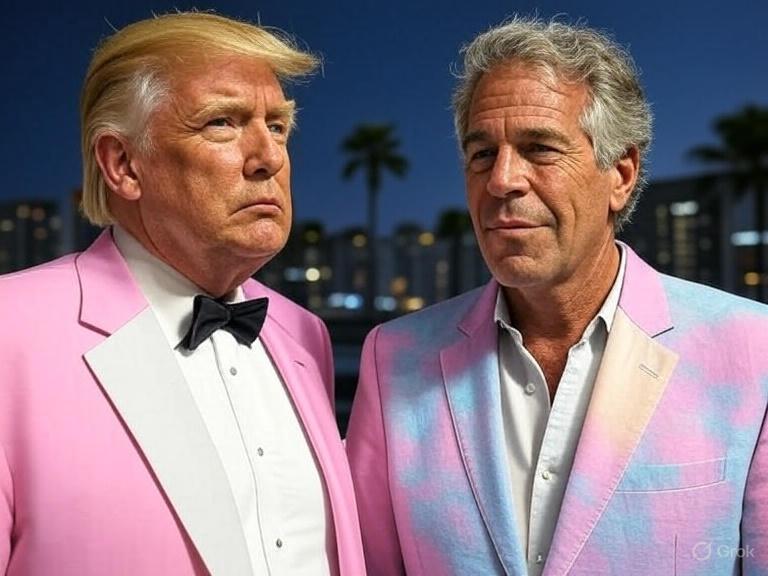
The Velvet Rope and the Ledger
Palm Beach in the 1990s was a cocktail that had gone flat: expensive, a little sour, and best swallowed without examining what was floating in the glass. Its crown jewel was Mar-a-Lago, Donald Trump’s Versailles-by-the-sea, where the ceilings were lined with gold leaf and the velvet rope was stitched from money, influence, and the tacit guarantee that whatever happened inside would never reach print.
Trump likes to tell a story. As the decade wound down, he says Jeffrey Epstein crossed a line and was summarily ejected. A clean break, the kind a man could polish and display when reporters came calling.
But clean breaks are for fairy tales. The ledgers — those dull, unblinking witnesses — suggest Epstein kept paying his dues long after the supposed exile. Paper doesn’t care for politics.
The Public Story
On July 9th 2019, in the Oval Office, a month before Epstein hanged himself, Trump leaned into the cameras and offered the official line: “I was not a fan… I haven’t spoken to him in maybe 15 years. I was not a fan.”
That arithmetic placed their rupture around 2004 — safely before Epstein’s 2006 indictment on sex-crime charges in Florida, and conveniently in the wake of a public spat over a bankrupt Palm Beach mansion. Trump won that duel, paying $41m for “Maison de l’Amitié”.
Recently, Trump has polished his tale further, casting himself as the virtuous actor. The documents, however, tell a plainer story: inconsistency, dishonesty, and timelines that refuse to bend.
By July 2025, Trump’s embellishments had become bolder. He told reporters Epstein had “stolen people who worked for me”, singling out Virginia Giuffre, one of Epstein’s most prominent accusers. She long testified that Ghislaine Maxwell recruited her at Mar-a-Lago in 2000, when she was a minor working at the club’s spa. That was not illegal, but hardly flattering.
Giuffre’s account — bolstered by legal filings and interviews — describes Maxwell approaching her on the job, then drawing her into Epstein’s world. Trump’s framing, that she was “stolen”, transforms a tale of exploitation into one of petty theft. No journalist pressed the more damning question: why was an underage girl working in Trump’s spa at all?
The records raise another difficulty. Court filings confirm Giuffre’s employment ended in 2000, two years before Trump told New York magazine that Epstein “likes them young” and described him as a “Terrific guy. He’s a lot of fun to be with.” A detail that reveals the men remained close well after Giuffre had been recruited.
Public records are also rude dinner guests: they interrupt, contradict, and refuse to be charmed.
Whether the break came after a real-estate feud in 2004 or over poached staff in 2000, The Grifter’s Club, a book by Miami Herald reporters, notes Epstein’s Mar-a-Lago membership wasn’t cancelled until October 2007.
That is three years beyond the date Trump implied in his Oval Office statement. The New York Times and PBS, careful to note “little public record” of ties after 2004, nonetheless concede that the 2007 ban was the final severing.
So why the lag? If Epstein was persona non grata in 2004, why did the books show him paying dues until 2007? The question is not abstract. In politics, controlling the timeline means controlling the story. Here, there are two: one for public consumption, another for the archives.
Mar-a-Lago is not mere backdrop. It is a character, bejewelled in daylight, complicit in silence at night. Membership buys more than cocktails by the pool; it secures entry into a world where scandals are managed behind closed doors.
The rope at the entrance is symbolic. The true barrier is made of connections and unspoken bargains. For Epstein, whose Rolodex could crack most locks, the barrier held until it did not.
Power’s selective Memory
History written in speeches is pliable. History written in flight logs and membership ledgers is not.
As early as March 1993, Trump and Epstein’s names rode together on flights between Teterboro and Palm Beach. On August 13th 1995, Trump brought his son Eric along for the ride north. By January 1997, Epstein, Maxwell, and Trump were airborne again, this time out of Newark.
Planes are just rooms without corners; the shadows travel with you.
Trump’s line about a “fifteen-year” split casts daylight over that past and Epstein’s later disgrace. The paper trail draws him back, at least until late 2007. Power does not erase inconvenient history — it rewrites it in just enough detail to pass the next news cycle.
The Ledger Never Blinks
The Mar-a-Lago books cannot preen for the cameras. The court documents bearing Virginia Giuffre’s testimony do not play for sympathy. They simply sit, yellowing, stubborn, waiting to be read.
And when they are, the bedtime stories collapse: the tale of a property feud in 2004, or a stolen staffer in 2000. None explains why Epstein’s name kept appearing in the ledgers until 2007, a year after his first charges thundered down. None explains why Trump was praising him as a “Terrific guy” two years after claiming he had barred him from Mar-a-Lago.
Fairy tales demand clean breaks. The ledger does not.
My sources are your sources (except for the secret ones): WPBF, Fox News, Miami Herald, Newsweek, Guardian, PBS, 7 Eye Witness News, Wikipedia, Polifact, ref="https://www.nbclosangeles.com/news/local/trump-epstein-video/139763/">NBC, Getty, NYMag, Daily Beast.